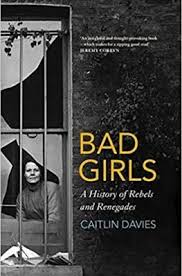Mary Hannity at the LRB:
 Between 1906 and 1914 hundreds of suffragettes were imprisoned and force-fed in Holloway. They turned their resistance to prison rules into a political programme. Suffragette prisoners were held separately and forbidden from communicating, but if one of them smashed a window to protest against poor air quality, for instance, the others would follow suit. They documented their treatment and smuggled out letters and diaries. The WSPU rented a house nearby, and used it as a base to communicate with the prisoners – and to throw bombs and bottles at the prison. Suffragettes were greeted on release by applauding crowds. The governor resigned. ‘If you are not a rebel before going into Holloway, there is no reason to wonder at your being one when you come out,’ wrote Edith Whitworth, secretary of the Sheffield branch of the WSPU. The imprisonment of middle-class women, which was unusual, helped draw public attention to the treatment of incarcerated women in general, and the suffragettes agitated for improved prison conditions. Davies gives ample attention to their use of Holloway as an icon of struggle: a Holloway flag was waved on suffragette marches; Christmas cards were produced with an illustration of the prison (‘Votes and a Happy Year’); there were Holloway diaries, demonstrations, songs and poems (‘Oh, Holloway, grim Holloway/With grey, forbidding towers!/Stern are the walls, but sterner still/Is woman’s free, unconquered will’).
Between 1906 and 1914 hundreds of suffragettes were imprisoned and force-fed in Holloway. They turned their resistance to prison rules into a political programme. Suffragette prisoners were held separately and forbidden from communicating, but if one of them smashed a window to protest against poor air quality, for instance, the others would follow suit. They documented their treatment and smuggled out letters and diaries. The WSPU rented a house nearby, and used it as a base to communicate with the prisoners – and to throw bombs and bottles at the prison. Suffragettes were greeted on release by applauding crowds. The governor resigned. ‘If you are not a rebel before going into Holloway, there is no reason to wonder at your being one when you come out,’ wrote Edith Whitworth, secretary of the Sheffield branch of the WSPU. The imprisonment of middle-class women, which was unusual, helped draw public attention to the treatment of incarcerated women in general, and the suffragettes agitated for improved prison conditions. Davies gives ample attention to their use of Holloway as an icon of struggle: a Holloway flag was waved on suffragette marches; Christmas cards were produced with an illustration of the prison (‘Votes and a Happy Year’); there were Holloway diaries, demonstrations, songs and poems (‘Oh, Holloway, grim Holloway/With grey, forbidding towers!/Stern are the walls, but sterner still/Is woman’s free, unconquered will’).
more here.
